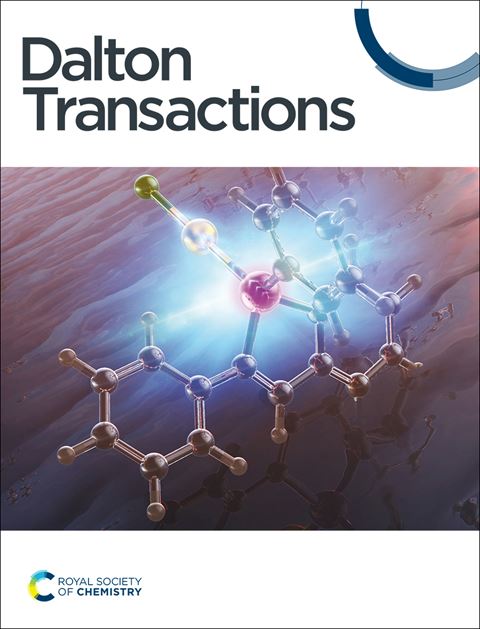Photocatalyst based on transition metal-Schiff base ligand and V-doped Kegging-type polyoxometalate for efficient and stable CO2 reduction
IF 3.5
3区 化学
Q2 CHEMISTRY, INORGANIC & NUCLEAR
引用次数: 0
Abstract
In order to simultaneously control the greenhouse effect and solve the problem of energy depletion, the strategy of converting CO2 into other energy can be used. In this work, two Keggin-type polyoxometalate-based compounds were synthesized by the hydrothermal method: [(Co(C11H15N7O2)(H2O)2]4{[(Co(C11H15N7O2)(H2O)]2(PWVI11VIVO40)} (PWVI9WV2VIVO40)·14.5H2O (1) and [(Fe(C11H15N7O2)(H2O)2]3{[(Fe(C11H15N7O2)(H2O)]2(BW12O40)}(BW12O40)·11H2O (2). Structural analysis of compound 1 indicate that an interesting V-doped Keggin-type (PWVI11VIVO40)5- anion is succesfully bonded two [(Co(C11H15N7O2)(H2O)]2+ cations to generate a hybrid [(Co(C11H15N7O2)(H2O)]2(PWVI11VIVO40) unit. Through a series of photocatalytic CO2 reduction reaction (CO2RR) experiments, it was found that compound 1 has good photocatalytic performance. The CO generation rate can reach 7081.4 μmol·g-1·h-1 and the selectivity is 83.8%. In addition, the stable and efficient photocatalytic activity of compound 1 was verified after four cycle photocatalytic experiments, which provided a new idea for CO2 photoreduction to CO. While the CO production rates of 103.5 μmol·g-1·h-1 for compound 2. This is because the adsorption energy of CO on Co is lower than Fe. Furthermore, the V-modified of compound 1 enhance CO2 adsorption to promote CO2 conversion.基于过渡金属-希夫碱配体和v掺杂kegging型多金属氧酸盐的高效稳定CO2还原光催化剂
为了同时控制温室效应和解决能源消耗问题,可以采用将二氧化碳转化为其他能源的策略。本文采用水热法合成了两个keggin型多金属氧酸盐基化合物[(Co(C11H15N7O2)(H2O)2]4{[(Co(C11H15N7O2)(H2O)]2(PWVI11VIVO40)} (PWVI9WV2VIVO40)·14.5H2O(1)和[(Fe(C11H15N7O2)(H2O)2]3{[(Fe(C11H15N7O2)(H2O)]2(BW12O40)}(BW12O40)·11H2O(2))。化合物1的结构分析表明,一个有趣的v掺杂keggin型(PWVI11VIVO40)5-阴离子成功地结合了两个[(Co(C11H15N7O2)(H2O)]2+阳离子,生成了一个杂化的[(Co(C11H15N7O2)(H2O)]2(PWVI11VIVO40)单元。通过一系列光催化CO2还原反应(CO2RR)实验,发现化合物1具有良好的光催化性能。CO生成速率可达7081.4 μmol·g-1·h-1,选择性为83.8%。另外,通过4个循环的光催化实验,验证了化合物1具有稳定高效的光催化活性,为CO2光还原为CO提供了新的思路,而化合物2的CO产率为103.5 μmol·g-1·h-1。这是因为CO在CO上的吸附能低于Fe。此外,化合物1的v修饰增强了CO2吸附,促进了CO2的转化。
本文章由计算机程序翻译,如有差异,请以英文原文为准。
求助全文
约1分钟内获得全文
求助全文
来源期刊

Dalton Transactions
化学-无机化学与核化学
CiteScore
6.60
自引率
7.50%
发文量
1832
审稿时长
1.5 months
期刊介绍:
Dalton Transactions is a journal for all areas of inorganic chemistry, which encompasses the organometallic, bioinorganic and materials chemistry of the elements, with applications including synthesis, catalysis, energy conversion/storage, electrical devices and medicine. Dalton Transactions welcomes high-quality, original submissions in all of these areas and more, where the advancement of knowledge in inorganic chemistry is significant.
 求助内容:
求助内容: 应助结果提醒方式:
应助结果提醒方式:


